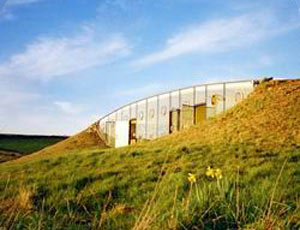Thousands of people stood silent in the streets of Poland's cities
Sunday, in a silent memorial to
President Lech Kaczynski and the other 95
people killed in a devastating plane crash.
The two minutes of silence were preceded by the
thundering pealing of church bells and din of emergency sirens for
nearly a minute before everything faded away. In front of the
presidential palace, hundreds of people stopped what they were doing and
stood, some with their eyes closed and heads bowed.
Earlier, at the
Field Cathedral of the Polish Army in
Warsaw, hundreds gathered
for a morning Mass and left flowers and written condolences. Among the
dead were
Poland's army
chief of staff, the navy chief commander, and heads of the air
and land forces, who were all making the emotional trip to honor Polish
officers slain by the
Soviet
secret police in 1940 in and near the forest of
Katyn in western Russia.
In Moscow, Russia's transport ministry said that
Russian and Polish investigators had begun to decipher
flight data recorders of
the aging Soviet-built Tu-154 airliner that crashed Saturday while
trying to land in deep fog in Smolensk, killing all aboard.
Russian officials had initially said 97 people were
killed but revised the figure to 96. Poland's Foreign Ministry also
confirmed the figure.
Polish government spokesman Pawel Gras said that
despite the loss of so many leaders, the country's armed forces were
operating normally, and all state offices were doing the same.
That the crash occurred near Katyn served as a stark
reminder to
Poland
of the horrors of that place. Kaczynski and those aboard the flight were
headed there to remember the thousands of Poles systematically executed
by Josef Stalin's
NKVD,
the forerunner to the KGB, in 1940.
About 4,000 Polish army officers were killed in Katyn
itself. In total some 22,000 officers and others were killed there and
in other areas.
Polish-Russian relations had been improving recently
after being poisoned for decades over the massacre.
Russia
never has formally apologized for the murders but
Russian Prime Minister Vladimir
Putin's decision to attend a memorial ceremony earlier this week
in the forest was seen as a gesture of goodwill toward reconciliation.
Kaczynski wasn't invited to that event because Putin, as prime minister,
had invited his Polish counterpart,
Donald Tusk.
In
Warsaw
on Sunday, one mourner, Boguslaw Staron, said he turned out to honor
Kaczynski, "a great patriot."
"He taught Poles how to respect our traditions, how
to fight for our dignity, and he made he made his sacrifice there at
that tragic place," said Staron, 70.
Kaczynski, 60, was the first serving Polish leader to
die since exiled
World
War II-era leader Gen. Wladyslaw Sikorski in a mysterious plane
crash off Gibraltar in 1943.
The bodies of Kaczynski and his wife were expected in
Warsaw by early afternoon, the Foreign Ministry said. Kaczynski's twin
brother Jaroslaw flew to Smolensk on Saturday evening and identified the
bodies.
People also continued to stream to the stately
presidential palace in Warsaw's historic center, where large sections of
the street were blocked to traffic to allow the flow of people
expressing their grief. Mourners carried candles and roses and joined a
long line to sign a book of condolences in the palace.
Lech Walesa, the anti-communist dissident who went on
to become Polish president, was among those who signed the book. A day
earlier he called the crash the nation's greatest misfortune since
Katyn. "The elite of
our country has perished," Walesa said.
Children also placed simple drawings and messages of
mourning: "I love our president," said one, alongside a picture of a
human figure and a cross.
Polish television carried black-and-white montages of
those killed in the crash and devoted nonstop coverage to the crash,
including lingering looks at Kaczynski and his wife, Maria Kaczynska.
Besides Kaczynski, aboard the plane were the national bank president,
the deputy foreign minister, the
army chaplain, the head of the
National Security Office,
the deputy parliament speaker, the Olympic Committee head, the
civil rights commissioner
and at least two presidential aides and three lawmakers.
Some on board were relatives of the officers slain in the
Katyn massacre. Also
among the victims was
Anna
Walentynowicz, whose firing in August 1980 from the Lenin
Shipyards in Gdansk sparked a workers' strike that spurred the eventual
creation of the
Solidarity
freedom movement.
President Dmitry Medvedev
declared Monday a day of mourning in
Russia.
Polish and Russian investigators were examining the plane's recorders,
which will be key to the investigation because they contain crew
conversations and flight data essential to determine the cause of the
Tu-154's crash.
The Tu-154 was the workhorse of Eastern Bloc civil aviation in the 1970s
and 1980s.
Poland
has long discussed replacing the planes that carry the country's
leaders but said it lacked the funds.
According to the Aviation Safety Network, there have been 66 crashes
involving Tu-154s in the past four decades, including six in the past
five years. The Russian carrier Aeroflot recently withdrew its Tu-154
fleet from service, largely because the planes do not meet international
noise restrictions and use too much fuel.
The Polish presidential plane was fully overhauled in December, the
general director of the Aviakor aviation maintenance plant in Samara,
Russia, told Rossiya-24. The plant repaired the plane's three engines,
retrofitted electronic and navigation equipment and updated the
interior, Alexei Gusev said. He said there could be no doubts that the
plane was flightworthy.
News of the crash left Poland reeling, grasping for answers.
"I was traveling on a plane last night and everyone was discussing the
crash — why it happened and what comes next for Poland," said Hanna
Wojcik, 70, in
Warsaw.
"And everybody was saying that it is some tragic fate for the nation
that it loses its most valuable sons near
Katyn."
David Mikael Taclino
Inyu Web Development and Design
Creative Writer






























